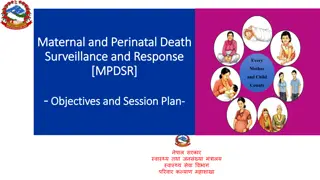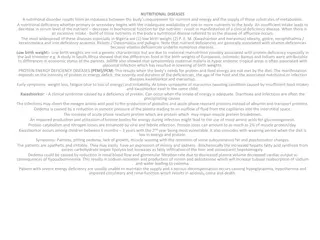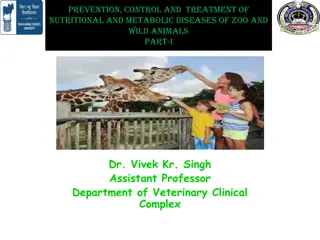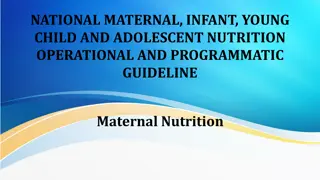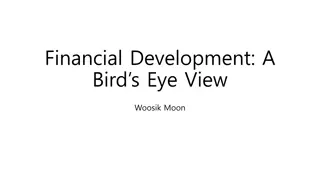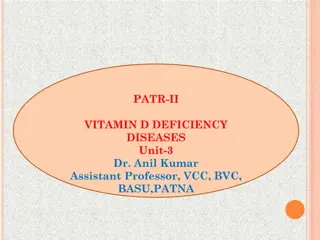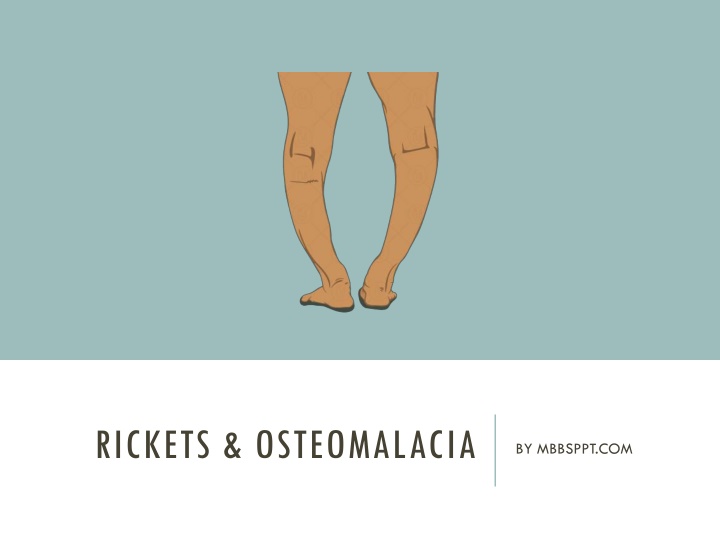
Rickets and Osteomalacia: Causes and Management
Learn about rickets and osteomalacia, diseases affecting bone health, their etiology, including vitamin D deficiencies, calcium and phosphorus deficiencies, renal losses, and nutritional factors. Explore the implications of malabsorption disorders on bone health. Stay informed on the common causes and risk factors associated with these conditions to ensure early detection and appropriate management strategies.
Download Presentation

Please find below an Image/Link to download the presentation.
The content on the website is provided AS IS for your information and personal use only. It may not be sold, licensed, or shared on other websites without obtaining consent from the author. If you encounter any issues during the download, it is possible that the publisher has removed the file from their server.
You are allowed to download the files provided on this website for personal or commercial use, subject to the condition that they are used lawfully. All files are the property of their respective owners.
The content on the website is provided AS IS for your information and personal use only. It may not be sold, licensed, or shared on other websites without obtaining consent from the author.
E N D
Presentation Transcript
RICKETS & OSTEOMALACIA BY MBBSPPT.COM
RICKETS Disease of Growing Bones. Occurs in Children Before Fusion of Epiphysis. Due to Defective Mineralization of Matrix at Growth Plates. Mineralization is Delayed or Inadequate, But Osteoid Continues to Expand, Growth Plate Thickens and Increase in Circumference of Growth Plate. Softening of the Bones Deformities. MBBSPPT.COM 2
VITAMIN D METABOLISM MBBSPPT.COM 3
ETIOLOGY OF RICKETS Vitamin-d Disorders: Nutritional Vitamin D Deficiency Congenital Vitamin D Deficiency Secondary Vitamin D Deficiency Malabsorption Increase Degradation Decreased Liver 25-hydroxylase Vitamin D dependent Rickets Type 1 Vitamin D dependent Rickets Type 2 MBBSPPT.COM 4
Calcium Deficiency: Low Intake Diet. Premature Infants (Rickets of Prematurity) Malabsorption. Primary Disease of Intestine. Dietary Inhibitors of Calcium Absorption. Phosphorus Deficiency: Inadequate Intake Premature Infants (Rickets Of Prematurity). Aluminum-containing Antacids. MBBSPPT.COM 5
RENAL LOSSES Tumor-inX-linked hypophosphatemic rickets. Autosomal dominant hypophosphatemic rickets. Autosomal recessive hypophosphatemic rickets. Overproduction of phosphatonin: Tumor-induced rickets McCune-Albright syndrome Epidermal nevus syndrome Neurofibromatosis Fanconi syndrome. Dent disease. Distal renal tubular acidosis. MBBSPPT.COM 6
NUTRITIONAL RICKETS Due To Lack of Vitamin D. Commonest Cause. Most Common In Infancy. Lack of Exposure To U/ V Sun Light Dark Skin Covered Body Kept In-door Exclusive Breast Feeding Limited Intake of Vitamin d Fortified Milk and Diary Products. During Rapid Growth Infancy Puberty Transplacental Transport of Vit D Provide Enough Vit D For First 1 To 2 Months of Life. MBBSPPT.COM 7
MALABSORPTION Celiac Disease Pancreatic Insufficiency Cystic Fibrosis Hepato-biliary Disease Biliary Artesia Cirrhosis Neonatal Hepatitis Drugs Anti-convulsants Phenobartbitone & Phenytoin Diet Excess of Phytate In Diet Will Impaired Calcium Absorption. MBBSPPT.COM 8
CLINICAL FEATURES Peak Incidence 6M 2 Years. Irritability. Profuse Sweating While Asleep. Hypotonia, Protruding Abdomen. Frequent Respiratory Infections. Failure To Thrive. Delay In Walking. Delayed Dentition. Fits, Tetany. MBBSPPT.COM 9
SIGNS Head. Larger Than Normal. Frontal Bossing. Craniotabes (Ping Pong Ball Sensation) Due To Thinning of Outer Table Of Skull. Delayed Closure of Anterior Fontanel. Caput Quadratum (Square Like Head). MBBSPPT.COM 10
THORAX Rachitic Rosery (Prominent Costochondral Junctions). Harrison s Sulcus (Depression Above the Subcostal Margin at the Site of Diaphragm). Pulling of Softened Ribs by the Diaphragm During Inspiration. Pigeon Chest Deformity. (The Weakened Ribs Bend Inwards due to The Pull of Respiratory Muscles and Causing Anterior Protrusion of Sternum). Respiratory Infections atelectasis. MBBSPPT.COM 11
RACHITIC ROSARY PIGEON CHEST DEFORMITY HARRISON SULCUS AND POT BELLY MBBSPPT.COM 12
EXTREMITIES Enlargement of Wrists And Ankles. Valgus or Varus Deformities. Windswept Deformity (Combination of Valgus Deformity of One Leg With Varus Deformity of The Other Leg). Anterior Bowing of The Tibia And Femur. Coxa Vara. Leg Pain. MBBSPPT.COM 13
WIDENING OF WRISTS MBBSPPT.COM 14
WIDENING OF ANKLE JOINTS MBBSPPT.COM 15
BENDING OF LONG BONES MBBSPPT.COM 16
KNOCK KNEE (GENU VALGUM) MBBSPPT.COM 17
GENU VARUM MBBSPPT.COM 18
WIND SWEPT DEFORMITY MBBSPPT.COM 19
BACK SCOLIOSIS - KYPHOSIS - LORDOSIS MBBSPPT.COM 20
HYPOCALCEMIC SYMPTOMS Tetany Seizures Stridor due to Laryngeal Spasm. MBBSPPT.COM 21
CLINICAL EVALUATION Dietary History Cutaneous Synthesis Maternal Risk Medication Malabsorption Renal Disease Family History Physical Examination Lab Test. MBBSPPT.COM 22
LAB DATA 1. Serum Calcium-low (Normal 9-11mg/Dl). 2. Serum Phosphorus-low (Normal-5-7mg/Dl). 3. Alkaline Phosphatase is Raised. This is the most Striking Feature, Shows Increased but Ineffective Activity of Osteoblasts. 4. 25-(oh) D Levels Less Than 20 Ng/Dl. Confirms of Vitamin D Deficiency. MBBSPPT.COM 23
LABORATORY FINDINGS Elevated: Decreased: 1. Alkaline Phosphatase. 1. Calcium Phosphorus. 2. Parathyroid Hormone. 2. Hydroxyvitamin D. MBBSPPT.COM 24
Disorder Ca Pi PTH 25-(OH)D 1,25-(OH)2D ALK PHOS URINE Ca URINE Pi VitaminD N, , N, Deficiency N, VDDR, Type 1 N N, VDDR, Type 2 N Chronic Renal Failure N, N, N Dietary Pi Deficiency N, N N Xlh Adhr Hhrh Arhr N N N N N N N N N N Rd Rd Rd Rd N, N Tumor-induced Rickets N N N Rd Fanconi Syndrome RD Or Or N N N Dietary Ca Deficiency N, N
RADIOLOGICAL FINDINGS: Generalized Osteopenia. Widening of the Unmineralized Epiphyseal Growth Plates. Fraying of Metaphysis of Long Bones. Bowing of Legs. Pseudo-fractures (Also Called Loozer Zone). Transverse Radio Lucent Band, Usually Perpendicular to Bone Surface. Complete Fractures. Features of Long-Standing Secondary Hyperparathyroidism (Osteitis Fibrosa Cystica). Sub-periosteal Resorption of Phalanges. Presence of Bony Cyst (Brown Tumor). MBBSPPT.COM 26
Wrist x-rays in a normal child (A) and a child with rickets (B). Child with rickets has metaphyseal fraying and cupping of the distal radius and ulna. MBBSPPT.COM 27
TREATMENT Stoss Therapy >3,00,000 6,00,000 IU Vitamin D Oral or IM, 2-4 Doses. Alternatively High Dose Vit D, 2000-5000 Iu/Day Over 4-6 Wks. Followed by Oral Vit D : < 1 Year Of Age - 400iu > 1 Years Of Age- 600IU Symptomatic Hypocalcemia 100 Mg/Kg IV Calcium Gluconate followed by Oral Calcium or Calcitriol -0.05mcg/Kg/Day. MBBSPPT.COM 28
PREVENTION 1. Exposure to Sunlight (Ultraviolet Light). Early Morning and Evening 30 Minutes Per Day. 2. Food Fortified With Vit A and Vit D Specially Butter, Ghee and Milk. Children Under 5 Should Have 500ml of Milk Daily or Yoghurt or Cheese Daily. Daily Intake of 400 Iu Vitamin D by Supplementation. Lactating Mothers should receive Supplementation with Milk or Vitamin D to Ensure Prevention of Rickets in their Babies. MBBSPPT.COM 29
PROGNOSIS 1. Most of Children have Excellent Prognosis. 2. Severe Disease-Causing Permanent Deformity and Short Stature. MBBSPPT.COM 30
VITAMIN DDEPENDENT RICKETS, TYPE 1 1. Autosomal Recessive Disorder. 2. Mutations in the Gene Encoding Renal 1 -hydroxylase. 3. 1st 2yr of Life. 4. Classic Features of Rickets with Symptomatic Hypocalcemia. 5. Normal Levels of 25-d. 6. Low or Normal Levels of 1,25-d. 7. Renal Tubular Dysfunction - Metabolic Acidosis and Generalized Aminoaciduria. 8. Treatment - 1,25-d (Calcitriol) - 0.25-2 Micro G/Day. MBBSPPT.COM 31
VITAMIN DDEPENDENT RICKETS, TYPE 2 1. Autosomal Recessive Disorder. 2. Mutations in Gene Encoding Vitamin D Receptor. 3. Levels of 1,25-d are Extremely Elevated. 4. Present During Infancy, might not be diagnosed Until Adulthood. 5. 50-70% of Children have Alopecia, range from Alopecia Areata to Alopecia Totalis. 6. Epidermal Cysts are less common. MBBSPPT.COM 32
TREATMENT 1. Extremely high doses of vitamin D2, 25-D or 1,25-D. 2. 3-6 mo trial of high-dose vitamin D and oral calcium. The initial dose of 1,25- D should be 2 micro g/day, but some patients require doses as high as 50-60 micro g/day. Calcium doses are 1,000-3,000 mg/day. 3. Treatment of patients who do not respond to vitamin-D is difficult. MBBSPPT.COM 33
HYPOPHOSPHATEMIC RICKETS X-Linked Hypophosphatemia Rickets. The defective gene is on the X chromosome, but female carriers are affected, so it is an X linked dominant disorder. The defective gene is called PHEX because it is a Phosphate-regulating gene with homology to Endopeptidases on the X chromosome. Clinical Manifestations: Rickets. Abnormalities of the Lower Extremities. Poor Growth. Delayed Dentition. MBBSPPT.COM 34
Laboratory Findings: Hypophosphatemia. Increased alkaline phosphatase; PTH and serum calcium levels are normal. Low or inappropriately normal levels of 1,25-D. Treatment: Oral phosphorus and 1,25-D (calcitriol). The daily 1-3 g of elemental phosphorus divided into 4- 5 doses. Calcitriol is administered 30-70 ng/kg/day divided into 2 doses. MBBSPPT.COM 35
MBBSPPT.COM 36



